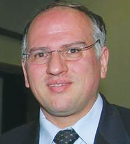Pulling together the 2020 American Association of Cancer Research (AACR) Virtual Annual Meeting in less than 1 month was a Herculean task, and an important component was producing a session on COVID-19 and cancer care. This special session involved researchers from the front lines of the pandemic in hotspots in Europe, China, and the United States. Antoni Ribas, MD, PhD, Chair of the COVID-19 and cancer session, Program Chair of the 2020 AACR Annual Meeting, and newly inaugurated AACR President, explained how this special session came to be and discussed highlights from it.

Antoni Ribas, MD, PhD
“This session included data generated over the past 2 months from investigators working with patients who have COVID-19 and cancer,” Dr. Ribas explained. “It is not usually how cancer data are generated, and the speakers had little time to learn how to record presentations. We wanted to learn from data gathered by people who were treating patients in key areas of the world. This is a rapidly evolving field, and some of the early information may not be 100% applicable, given biases in different series. Information that we gather will help generate hypotheses for the development of treatment approaches.”
Dr. Ribas acknowledged the speakers as heroes, putting their lives at risk. “They are taking care of these patients and gathering data that could help others. I approached them to speak because they are working at centers that were the hardest hit,” he noted. “However, these data are preliminary.”
The AACR will host another COVID-19 and cancer session during the June 22–24 Virtual Meeting. In July, the AACR will present a 2-day virtual conference based on abstracts and peer reviews for select presentations.
Studies From China
Separate studies from China suggested that outcomes are worse and the disease course of COVID-19 is more aggressive in patients with cancer. The first was a retrospective cohort of patients with cancer and confirmed COVID-19 infection from three designated hospitals in Wuhan, China, from January 13, 2020, to February 26, 2020.1 Li Zhang, MD, of Tongji Hospital, Wuhan, China, was the presenting author.

Li Zhang, MD
This analysis included 28 patients with cancer and COVID-19; the median age was 65, and 60% were male. Among these patients, 25% had lung cancer, and 28.6% were assumed to be infected from hospital-associated transmission of COVID-19. Fifteen patients (53.9%) developed severe COVID-19 infection, and 28.6% died. Risk factors for developing severe COVID-19 infection (ie, admission to the intensive care unit [ICU], ventilation, or death) appear to be anticancer treatment within 14 days of the diagnosis of the infection and patchy consolidation of the lungs. This series also followed 124 patients with cancer who received immune checkpoint inhibitors and their risk factors for severe events.
A second study from China—the first large cohort on this topic—was a multicenter retrospective study that included 105 patients with cancer and 536 age-matched patients with COVID-19 infection who did not have cancer and served as controls.2 Hongbing Cai, MD, of Zhongnan Hospital of Wuhan University, Wuhan, China, was the presenting author.
Patients with COVID-19 and cancer had higher risks of more severe outcomes; in particular, patients with lung, hematologic, or metastatic cancer had the highest risk of severe events. Patients with nonmetastatic cancer experienced similar outcomes as those observed in patients who did not have cancer. Surgery, but not radiation therapy, increased the risk of severe events in patients with both COVID-19 and cancer compared with patients who did not have cancer.
Perspective on Wuhan Studies
Dr. Ribas offered his perspective on the two Chinese studies. “Both were recently published [Annals of Oncology3 and Cancer Discovery,4 respectively] and suggest that patients with cancer who become infected with COVID-19 do worse than those patients who do not have cancer. This information should be taken into context with the presentations from Italy, Spain, and France (discussed below).”
According to Dr. Ribas, it may not be the cancer diagnosis that leads to worsening disease; it may be comorbid conditions and actively receiving chemotherapy that worsen the prognosis. “Comorbid conditions in the lung, smoking history, poor lung function, primary lung cancer, or metastasis to the lungs may explain the worse prognosis,” he continued. “This virus replicates in cells from the airway, and if the airway is compromised, it is logical that patients would become more severely ill with COVID-19 infection. More smoking and more lung disease in patients from China may explain the results of those two studies.”
TERAVOLT Global Registry
Patients with thoracic cancer and COVID-19 are considered to be at high risk, since they have many risk factors that may include a history of smoking, preexisting cardiovascular or respiratory disease, older age, and other comorbidities. This was the impetus for the TERAVOLT global registry of patients with thoracic malignancies and COVID-19. Thus far, 21 countries have joined the registry, which is endorsed by a number of scientific societies.5
“Things are moving very quickly. We are registering about 70 new cases per week from all over the world, and many centers have decided to join this registry,” said Marina C. Garassino, MD, a medical oncologist at the Fondazione IRCCS Istituto Nazionale dei Tumori, Milan, Italy, who presented early data from the global registry.

Marina C. Garassino, MD
Inclusion criteria for TERAVOLT are COVID-19 infection documented by real-time polymerase chain reaction, suspected COVID-19 infection on the basis of symptoms and exposure, radiologically suspicious cases with lung features consistent with COVID-19 on computed tomography (CT) scan, and asymptomatic cases confirmed with real-time polymerase chain reaction.
Among the first 200 patients with thoracic cancer who have COVID-19 infection enrolled in the registry, the death rate was 34.6%. The most frequent complications were pneumonia and pneumonitis (79.6%), acute respiratory distress syndrome (26.8%), multiorgan failure (7.6%), and sepsis (5.1%). The majority of deaths were attributed to COVID-19, not to cancer.
The data gathered on this first set of patients enrolled in the registry showed that 83.8% had comorbidities (more than one-quarter had three or more); 73.9% of patients were on anticancer treatment that included chemotherapy, immunotherapy, and combinations of these agents. Although 76% of patients required hospitalization for COVID-19 infection, 8.8% were admitted to the ICU, and mechanical ventilation was used in 2.5%, which may have been attributable to institutional shortages, she said.
Dr. Garassino encouraged oncologists to join the registry. “With a strong united community, we were able to activate a global registry and provide preliminary data in only 1 month in the absence of dedicated funding. My final thought is that it’s important not to go this alone; join the registries. We need to work together to get these data quickly to help our patients.”
“This is a well-organized and commendable effort,” stated Dr. Ribas. “It is important and impressive to prospectively register patients with thoracic malignancies and COVID-19 infection and provide this information in such a timely way. There are a lot of data to mine from this registry, and more findings will emerge from follow-up. These investigators showed the field how to do this in a hard-hit area of the world. We will have to continue to capture this information.”
French Perspective
Investigators at Gustave Roussy Institute, Paris, France, found that Eastern Cooperative Oncology Group (ECOG) performance status, cancer type, and type of prior cancer therapy were predictive of clinical worsening or death in patients with cancer infected with the virus.6 “An ECOG performance status > 1 and hematologic malignancies were the strongest predictors of clinical worsening [ie, need for oxygen support for 61 minutes or more or death due any cause],” said Fabrice Barlesi, MD, PhD, Medical Director of the Institute. “Smoking status and body mass index had no impact on clinical worsening.”

Fabrice Barlesi, MD, PhD
Dr. Barlesi drew from experience with 137 patients with cancer and confirmed COVID-19 infection treated at Gustave Roussy. The majority of these patients (84%) had solid tumors, and 16% had hematologic malignancies.
In univariate and multivariate analyses, chemotherapy within the past 3 months was associated with a higher risk of clinical worsening compared with not receiving chemotherapy in that period. Treatment with immunotherapy or targeted therapy within the past 3 months did not have an impact on clinical worsening.
The higher risk of COVID-19 worsening or death with chemotherapy was confined to those with active advanced disease. “This means that we may continue to treat patients with localized disease with cytotoxic chemotherapy in the adjuvant or neoadjuvant setting. We have to pay attention to factors like this when deciding how to treat patients with cancer and COVID-19,” Dr. Barlesi said.
Outcomes at Gustave Roussy were comparable to those in the rest of France, Dr. Barlesi noted. The mortality rate in the series he reported was 14.6%; clinical worsening was observed in 24.8% of patients (11% of them were admitted to the ICU). At the time of his presentation, 16.1% of patients were still hospitalized, and 69.3% were discharged or being treated as outpatients.
“The comorbid conditions best described in the Gustave Roussy series are prognostic factors [for worsening and severe outcomes], and that knowledge needs to be taken into consideration when determining the risk/benefit ratio of treating cancer,” suggested Dr. Barlesi. Patients with leukemia need to be treated regardless of COVID-19 infection, but in some cases of patients with other cancers, maintenance chemotherapy may not be needed and may place patients at increased risk.”
Melanoma and Beyond

Paolo A. Ascierto, MD
Paolo A. Ascierto, MD, of the Unit of Melanoma, Cancer Immunotherapy, and Development Therapeutics, National Tumor Institute Fondazione G. Pascale, Naples, Italy, discussed management implications for melanoma and immune oncology in general.7 His experience suggested that patients with larger lesions should be given priority for surgery. Surgery for smaller lesions (< 2 mm) can be safely delayed.
According to Dr. Ascierto, the highest priority should be given to patients with stage III melanoma eligible for curative resection, patients requiring resection for oligometastatic disease, and for surgical management of complications from surgery. He suggested that follow-up after surgery be done via telemedicine. Clinic visits should be postponed, especially if there is no evidence of disease.
Adjuvant treatment can be delayed for up to 12 weeks, and Dr. Ascierto recommended longer dosing intervals for checkpoint inhibitors, such as every 6 weeks for pembrolizumab and every 4 weeks for nivolumab. “For patients with metastatic disease, no stops or delays are advised for targeted therapies or immunotherapies for unresectable stage III to IV melanoma. If possible, use a longer treatment schedule,” he said.
Dr. Ascierto encouraged COVID-19 testing for patients with melanoma on immune checkpoint inhibitors with signs of pneumonitis on CT scan before giving steroids (which may worsen infection) as well as for patients treated with BRAF/MEK inhibitors who develop a fever that does not resolve with treatment interruption.
Lessons from immune oncology can be applied to the treatment of complications of COVID-19, particularly the inflammatory response leading to cytokine-release syndrome, which is also a complication of chimeric antigen receptor T-cell therapy. Interleukin-6 inhibitors such as tocilizumab, and more recently sarilumab, are being studied in the treatment of cytokine-release syndrome in COVID-19–infected patients. Other classes of oncology drugs may also be helpful, but studies are needed.
Experience From Spain
Carlos Gomez-Martin, MD, PhD, a medical oncologist at 12 de Octubre University Hospital, Madrid, discussed evolving strategies at his institution to deal with the COVID-19 pandemic.8 On March 5, the first patient with cancer was diagnosed with COVID-19 infection. That prompted efforts to contain the outbreak by testing all patients and caregivers suspected of the infection or who were in contact with anyone who had the disease. Outpatient visits were limited, and telemedicine was introduced for cancer-related symptom management. Patients with suspected or confirmed COVID-19 infection were transferred to designated wards, with multidisciplinary staff dedicated exclusively to the care of these patients.
Between March 9 and April 19, 2020, 287 patients with cancer were screened with real-time polymerase chain reaction for COVID-19 in the outpatient clinic and emergency room; 26% had a positive test. A total of 90 patients were admitted to the hospital; 55 had a positive real-time polymerase chain reaction test. The other 35 patients admitted had a risk factor for a poor outcome. This strategy kept oncology admissions steady over that period, and the number of total admissions at the hospitals rapidly increased to almost 1,200 patients.
Of the first 63 patients with cancer who were treated, 15 had lung cancer, 17 had gastrointestinal cancers, and 10 had breast cancer. Fifty-two patients (82%) had metastatic disease, and 40% had lung involvement (primary tumor or metastasis). More than half of patients (58%) were being treated with active chemotherapy; 26%, with endocrine therapy; and 12%, with immunotherapy.
Of the 63 patients, 16 (25%) died of COVID-19 infection, with a mean overall survival of 12.4 days. A total of 34 patients developed respiratory failure, and 24 developed acute respiratory distress syndrome; 66% of these patients died. The mean time from the onset of symptoms to respiratory failure was 7.02 days, and the mean time to hospital discharge was 14.8 days. Death occurred in 40% of patients with lung cancer (29% with metastatic disease), 100% with bilateral pneumonia, 62% with hypertension, and 31% for those who had prior steroids (> 10 mg). Of the 63 patients, 9 developed venous thromboembolism.
In the absence of randomized trials, treatment was empiric. Randomized trials are sorely needed, but until then, multidisciplinary care is the cornerstone of treatment. “This should involve specific antiviral treatment, supportive care, close monitoring of inflammatory parameters, and appropriate use of anticoagulants, given the risk of thromboembolic complications in this disease,” stated Dr. Gomez-Martin.
Flattening the Curve but Widening the Disparities

Louis P. Voigt, MD
Louis P. Voigt, MD, of Memorial Sloan Kettering Cancer Center, New York, gave a presentation on the disproportionate burden of COVID-19 infection and death among minorities and those of lower socioeconomic status.9 The charts and graphs he showed for New York City underscore the disparities in the number of nonhospitalized patients with COVID-19 infection, the number of nonfatal hospitalizations, and the number of known deaths; these rates are highest among blacks, with Latinos being a close second. These outcomes no doubt reflect disparities in access to care for minorities and for those with lower incomes.
“The strong presumption, based on data in the African American population, is that they have a higher incidence of cancer, cancer-related mortality, COVID-19 infection, and COVID-19–related mortality. The reality is more complex. We don’t have enough data, and we need more time [to follow these trends],” observed Dr. Voigt.
“Pandemics create perfect conditions for suboptimal deviation from the standard of care, with the major impact on the most vulnerable patients, as health-care systems become overwhelmed and decisions are driven by fear and emotions rather than evolving facts. We have an obligation to have a more robust safety net for vulnerable patients. It is time to stop talking the talk and start walking the walk,” Dr. Voigt emphasized.
Dr. Ribas agreed with the findings from Dr. Voigt’s presentation. “The most vulnerable people are the most at risk for COVID-19 infections and worse outcomes. The death rate shows the socioeconomic divide based on ethnicity and income. We are doing poorly, and we need to pay attention to this and treat all patients the same, making an extra effort knowing the most vulnerable among us will suffer more,” Dr. Ribas concluded.
DISCLOSURE: Dr. Ribas reported financial relationships with Amgen, Chugai, Genentech, Merck, Novartis, Sanofi, Advaxis, Arcus, Bioncotech, Compugen, CytomX, Five Prime, FLX Bio, ImaginAb, Isoplexis, Kite-Gilead, Merus, Rgenix, Lutris, PACT Pharma, and Tango Therapeutics. Dr. Garissino reported financial relationships with AstraZeneca, MDS International, GMBH, BMS, Boehringer Ingeheim Italia SPA, Celgene, Eli Lilly, Ignyta, Incyte, Inivata, MedImmune, Novartis, Pfizer, Roche, Takeda, and Seattle Genetics. Dr. Barlesi reported financial relationships with AstraZeneca, BMS, Boehringer-Ingelheim, Clovis, Eli Lilly, Hoffmann–La Roche, Novartis, Merck, Merck Sharp & Dohme, Pfizer, and Pierre Fabre. Dr. Ascierto reported financial relationships with BMS, Roche/Genentech, Merck Sharp & Dohme, Novartis, Array, Merck Serono, Pierre Fabre, Incyte, NewLink Genetics, Genmab, MedImmune, AstraZeneca, Syndax, Sun Pharma, Sanofi, Idera, Ultimovacs, Sandoz, and Immunocore. Dr. Gomez-Martin reported financial relationships with Eisai, Roche-Spain, BMS, Pfizer, Merck, AstraZeneca, Daiichi Sankyo, and Eli Lilly. Drs. Zhang, Cai, and Voigt reported no conflicts of interest.
REFERENCES
1. Zhang L, Zhu F, Xie L, et al: The experience of treating patients with cancer during the COVID-19 pandemic in China. 2020 AACR Virtual Annual Meeting. Session VCTPL09. Presented April 28, 2020.
2. Dai MY, Liu D, Liu M, et al: Patients with cancer appear more vulnerable to SARS-COV-2: A multicenter study during the COVID-19 outbreak. 2020 AACR Virtual Annual Meeting. Session VCTPL09. Presented April 28, 2020.
3. Zhang L, Zhu F, Xie L, et al: Clinical characteristics of COVID-19-infected cancer patients: A retrospective case study in three hospitals within Wuhan, China. Ann Oncol. March 26, 2020 (early release online).
4. Dai MY, Liu D, Liu M, et al: Patients with cancer appear more vulnerable to SARS-COV-2: A multi-center study during the COVID-19 outbreak. Cancer Discov. April 28, 2020 (early release online).
5. Garassino MC: TERAVOLT: First results of a global collaboration to address the impact of COVID-19 in patients with thoracic malignancies. 2020 AACR Virtual Annual Meeting. Session VCTPL09. Presented April 28, 2020.
6. Barlesi F, Foulon S, Bayle A, et al: Outcome of cancer patients infected with COVID-19, including toxicity of cancer treatments. 2020 AACR Virtual Annual Meeting. Session VCTPL09. Presented April 28, 2020.
7. Ascierto PA: Experience in using oncology drugs in patients with COVID-19. 2020 AACR Virtual Annual Meeting. Session VCTPL09. Presented April 28, 2020.
8. Gomez-Martin C: Adapting oncologic practice to COVID-19 outbreak: From outpatient triage to risk assessment for specific treatment in Madrid, Spain. 2020 AACR Virtual Annual Meeting. Session VCTPL09. Presented April 28, 2020.
9. Voigt LP: COVID-19 and cancer: Flattening the curve but widening disparities. 2020 AACR Virtual Annual Meeting. Session VCTPL09. Presented April 28, 2020.

